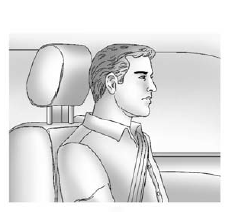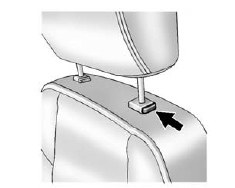Chevrolet Captiva Owners Manual: Seats and Restraints
Head Restraints
Warning
With head restraints that are not installed and adjusted properly, there is a greater chance that occupants will suffer a neck/ spinal injury in a crash. Do not drive until the head restraints for all occupants are installed and adjusted properly.

Adjust the head restraint so that the top of the restraint is at the same height as the top of the occupant's head. This position reduces the chance of a neck injury in a crash.
Front Seats
The vehicle's front seats have adjustable head restraints in the outboard seating positions.
The height of the head restraint can be adjusted. Pull the head restraint up to raise it. Try to move the head restraint to make sure that it is locked in place.

To lower the head restraint, press the button located on the top of the seatback, and push the head restraint down. Try to move the head restraint after the button is released to make sure that it is locked in place.
The front seat outboard head restraints are not designed to be removed.
Rear Seats
The vehicle's rear seats have adjustable head restraints in the outboard seating positions that can be adjusted the same way as the front head restraints.
Rear outboard head restraints are not designed to be removed.
Active Head Restraints
The vehicle has an active head restraint system in the front seating positions. These automatically tilt forward to reduce the risk of neck injury if the vehicle is hit from behind.
Chevrolet Captiva boasts a well-thought-out seating and restraint system designed to offer comfort, safety, and flexibility to occupants. Let's explore the key aspects of the front seats, rear seats, and active head restraints in this vehicle.
Front seats of the Chevrolet Captiva are crafted with a focus on ergonomics, ensuring that drivers and passengers experience a comfortable and supportive seating position during their journeys. These seats often come with various adjustment options such as seat height, lumbar support, and recline angle, allowing individuals to customize their seating preferences for maximum comfort. Some models may also feature power-adjustable seats with memory settings, catering to multiple drivers and enhancing convenience.
In the rear of the Captiva, passengers can enjoy generous space and comfort, making long rides more enjoyable for everyone. The rear seats typically offer a split-folding capability, enabling users to expand the cargo area as needed while maintaining seating capacity. Depending on the trim level, rear passengers may benefit from additional amenities like rear air vents, fold-down armrests with integrated cup holders, and USB charging ports, enhancing overall convenience and satisfaction for occupants.
Safety is paramount in the Captiva Sport, and the inclusion of active head restraints in the front seats underscores this commitment. Active head restraints are designed to mitigate the risk of neck injuries in rear-end collisions by automatically moving forward and upward to cushion the head and neck area. This feature helps reduce the impact of sudden rearward movement during accidents, providing an added layer of protection for front-seat occupants and contributing to overall vehicle safety.
Seating and restraint system in the Chevrolet Captiva (2006-2018) strikes a balance between comfort and safety, making it an appealing choice for daily commuting and family trips. Familiarizing oneself with the adjustable features and safety technologies available in the vehicle ensures a secure and pleasant ride experience for all occupants.
- Front Seats
- Seat Adjustment, Power Seat Adjustment, Lumbar Adjustment
- Reclining Seatbacks
- Heated Front Seats
- Folding Seatback
- Rear Seats
- Safety Belts
- Airbag System
- Child Restraints
 Roof
Roof
Sunroof
To operate the sunroof, the ignition
must be in ON/RUN, or ACC/
ACCESSORY, or Retained
Accessory Power (RAP) must be
active. See Retained Accessory
Power (RAP) on page 9-18.
Open ...
 Front Seats
Front Seats
...
More about:
Chevrolet Captiva Owners Manual > Warning Lights, Gauges, and Indicators: Fuel Gauge
Metric
English
When the ignition is on, the fuel
gauge indicates how much fuel is
left in the tank.
When the indicator nears empty, the
low fuel light comes on. There is still
a little fuel left, but the fuel tank
should be refilled soon. See Low
Fuel Warning Light on page 5-21 fo ...
Chevrolet Captiva Owners Manual
- Introduction
- In Brief
- Keys, Doors, and Windows
- Seats and Restraints
- Storage
- Instruments and Controls
- Lighting
- Infotainment System
- Climate Controls
- Driving and Operating
- Vehicle Care
- Service and Maintenance
- Technical Data
- OnStar
